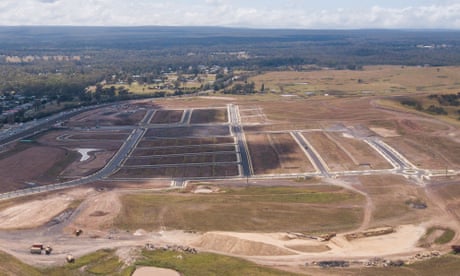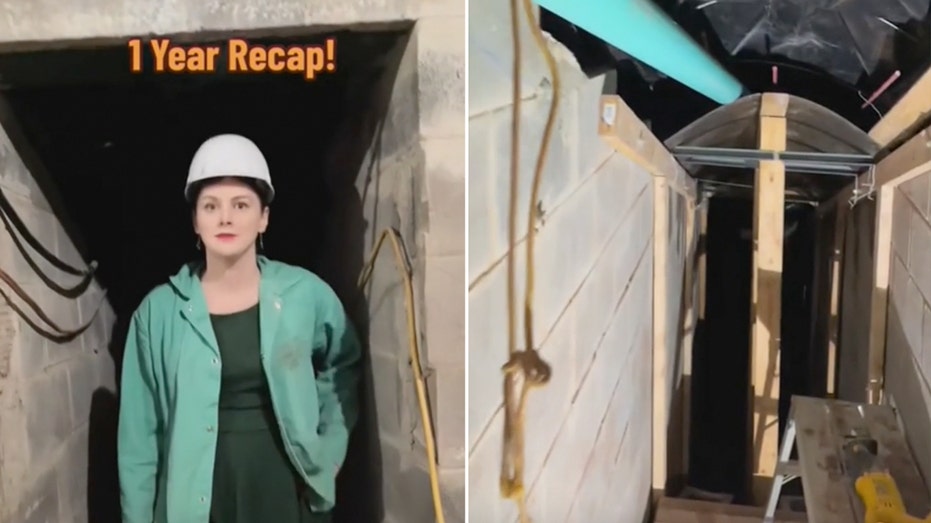- by foxnews
- 15 Mar 2025
‘It will be a disaster’: mayor’s dire warning over developer-led housing outside Sydney
‘It will be a disaster’: mayor’s dire warning over developer-led housing outside Sydney
- by theguardian
- 26 Feb 2023
- in news

Suburban utopias can be deceiving, as the residents of the once small village of Wilton are discovering.
Travel south down the Hume Highway out of Sydney and at the 80km mark new areas of Wilton are taking over paddocks. They have catchy bucolic names like Bingara Gorge, Wilton Greens and Panorama.
Thousands of houses are now being rolled out, but the infrastructure to support these new suburbs could be decades away.
In Wilton, blocks are being sold without sewer services. There's no clear answer about the future water supply for the area and the proposed new town centre, which was to provide up to 15,000 jobs, is still a skydiving centre.
Welcome to the world of developer-led progress.
Unlike the Aerotropolis near the new airport at Badgery's Creek, in Sydney's west, where there is a single authority and detailed plans for each development area, Wilton's four developers are each proceeding separately.
They have each signed a Voluntary Planning Agreement, negotiated with the state government and the local Wollondilly council, to provide infrastructure "at no cost to government". These commitments include sewerage and recycled water plants, community halls, parks and road interchanges to the existing network.
Bingara Gorge, which was first started in the 2000s by LendLease, is now being built by Metro. Wilton Greens is being built by Risland. Wilton North is now owned by Landcom, while the town centre is owned by a fourth developer, Cameron Brae.
But with four developers working independently, some critics say there is a real question mark about whether the infrastructure will be adequate, timely and coordinated.
"This is planning at its very worst, with profit for a handful of developers overriding the community interest," Greens MP and planning spokesperson, Cate Faehrmann, says.
"The government has wiped its hands of any responsibility to provide future residents of these suburbs with the basics such as sewerage, water, public transport and even a town centre."
The New South Wales premier, Dominic Perrottet, and his ministers have been trumpeting his government's accelerated infrastructure fund, which will hand over $900m over four years to councils to assist with infrastructure. But this is being spent over the entire state.
The Wollondilly mayor, Matt Gould, says his council estimates there is a $500m shortfall in the infrastructure needed to service the planned population of Wilton of 15,000. He says there is another $1.5bn shortfall for infrastructure for nearby Appin, which is now being fast-tracked by the Perrottet government.
"We are not against development. But we want to see the government concentrate on completing infrastructure for Wilton before embarking on a new area," he says. "Otherwise it will be a disaster."
Wilton has had an unusual path to inception.
The first part, Bingara Gorge, was approved under a loophole which allowed the then developer, LendLease, to obtain rezoning for a "community title" development - a form of development similar to strata where the community owns some common assets such as a pool or a golf course.
The other parts of the Wilton project were approved for rezoning by the NSW government in just over a year, despite concerns from Wollondilly council about the lack of infrastructure. The promise from developers at the time was that they would be allowed to jump the queue on the basis of providing the necessary infrastructure "at no cost to government".
But infrastructure is now a serious problem.
A community centre at Bingara Gorge has never materialised. The promised swimming pool is only open to residents because the development is "community title". The small supermarket in Bingara has closed while a new, bigger supermarket is being built, leaving the current 5,000-strong population of Wilton to drive to Picton or Appin about 14km away.
Wilton town centre, which is owned by the Hazlett family's company, Cameron Brae, is still waiting for signoff on its infrastructure plans and remains a skydiving centre. The chief executive of Cameron Brae, Angus McKenzie, said the company hoped it would soon reach agreement on the infrastructure plan.
Meanwhile, the 15,000 jobs in the vicinity that were envisaged in the plan for Wilton are years away. There is currently no plan for a hospital despite the region's population expected to reach 55,000 by 2040. The town's primary school is already at capacity.
As for water and sewerage, the situation is even more complex.
The convener of the Wilton Action Group, Brian Williams, says that some blocks are being sold off the plan without a "linen plan" - which includes the details of easements and sewerage and water infrastructure. Until that is produced, houses cannot be built.
Until recently Wilton was facing the prospect of having four small sewage plants as each developer is responsible for building its own wastewater treatment and recycling plant, and the pipes to provide services.
Sydney Water has now assumed operation of the Bingara Gorge recycled water plant, previously owned by LendLease, which may offer a short-term solution as it can service the area for a limited time, but it acknowledges that more treatment facilities will be needed.
Providing drinking water for the future population of 55,000 is even more challenging.
"Wilton is a mess," says Associate Prof Ian Wright, an environmental scientist from the Western Sydney University, who is an expert in the water resources of the region.
"It's sadly ironic that this area has given us some of the best drinking water but that now stands to be impacted by development," he says, warning that urban run-off could pose a serious threat to water quality.
As well as imperilling existing water supplies, Wright says the area's resources are inadequate to meet the future needs of the greater Macarthur region, whose population is expected to reach 600,000 by 2050.
Currently the region draws drinking water from the Cordeaux, Cataract and Avon dams, which are part of the Upper Nepean system - also the backup for Sydney's water supply.
During the recent floods, these smaller dams were critical to Sydney's water supply due to poor water quality in the massive Warragamba dam.
In the 2018-19 drought, when they were also important as backup for Sydney, these smaller dams dropped to below 20% of capacity.
The Wilton Action Group's water expert, Fiona Bullivant, says this raises questions about what will happen when the population of Wilton expands to the planned 15,000, let alone when Appin is developed - and there is another drought.
She says the areas are too far from the coast to rely on desalination plants.
Meanwhile the developers are just as frustrated with Sydney Water, whose website offers few clues as to the solutions.
"We've been investigating water management system options to accommodate the expected growth and meet projected demands for water-related services to 2046," Sydney Water's website says.
"The development of Wilton will require significant water-related infrastructure, such as new reservoirs, trunk mains, pumping stations and treatment facilities. This infrastructure and the timing of delivery depend on development uptake," it says.
When Guardian Australia asked Sydney Water to elaborate it said: "Infrastructure to service the ultimate Wilton Growth Area is currently being planned, designed and delivered over three stages in line with expected growth. Sydney Water is currently completing concept design for a range of infrastructure needed to service the growth area up to 2026."
"This will be sufficient to service about 4,700 additional dwellings and support about 4,200 additional jobs, the spokesperson said.
Critics say this is bureaucracy-speak for "we're working on a short-term plan, but we can't tell you what we will do in the long term, when there are 15,000 residents by 2040".
The individual developers are also responsible for the roads connecting their developments to the adjoining major arteries.
This has led to some bizarre outcomes.
Bingara Gorge Pty Ltd recently lodged a development application for an upgrade to the main turn-off into its estate from Picton Road. It is proposing a left turn in, left turn out only option for the increasingly busy intersection. The alternatives - traffic lights or a more expensive interchange - have not been proposed by the developer.
"It means those who want to turn right will need to traverse suburban roads on a 3km to 4km excursion to reach the alternative access to the Picton road," says Williams.
"It's just crazy. We have had a deluge on our Facebook from both locals and truck drivers working here," he says.
The traffic problems are being made worse by the fact that another developer, Landcom, has started construction at Wilton North but the planned access route - via the town centre - has not been built.
This means that B-double trucks are now negotiating their way through the surrounding suburban streets of Bingara Gorge - the only other access point.
These outcomes are now causing real heartache for Wilton residents, but there are many more new homeowners who will be affected in coming years.
"Its just wrong on so many levels," saysthe author, architecture critic and upper house independent candidate Elizabeth Farrelly.
She runs through a long list of problems: the eating up of farmland, the climate impact of relying on cars, the loss of koala habitat, destruction of mature trees and urban heat.
"We are building homes that will be ovens, that will be permanently dependent on air conditioning and we're selling them to people who can't afford to live closer to the city. They will just cook," she warns.
"We shouldn't be doing greenfields sprawl full stop. We should be looking at the middle ring - at Bankstown and Blacktown - and making them beautiful places to live, like Paddington and other [denser] suburbs," she said.
- by foxnews
- descember 09, 2016
Neighbors react as viral 'Tunnel Girl' granted permit to continue digging massive bunker under home
"Tunnel Girl" in Herndon, Virginia, "finally" got her tunnel project approved after pausing the project due to a potential violation. Locals and social media users react.
read more


